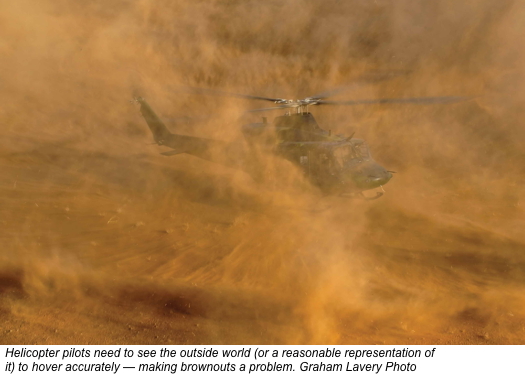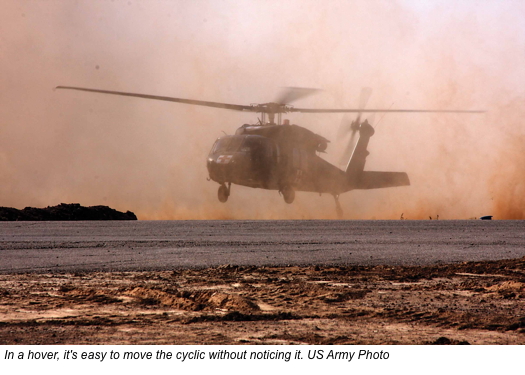
Like all airborne vehicles, a helicopter has to displace its own weight of air to stay aloft. For fixed-wing aircraft, all this air is left behind, as these restricted vehicles need forward motion through the air, and for helicopters in forward flight, the same applies. The disturbed air left behind is typically only a problem for someone following you, as those who have encountered wake vortices can attest. However, helicopters are of most use when maintaining position over the ground, especially with a wind from somewhere other than directly in front.
The same requirement to displace a mass of air still applies, and this is where the problems for the hovering helicopter can start if the underlying surface is less than solid. That mass of air you’re depending on for support often has a high velocity and can dislodge a lot of things. Things like the surface itself — dust, sand, or snow, for example. If you’re just having to hover, and can stay above the stuff that’s been dislodged, it’s a bit of nuisance and not much more. (We’ll leave out the problems this can create for engines in this discussion.) However, if you’re trying to land, and you’re blowing up so much of the surface that you can’t see properly, then you’ve got a major problem.
First of all, let’s look at the “seeing” problem. Helicopter pilots need to see the outside world, or a reasonable representation of it, to be able to hover or move around accurately. This requires visual information about location over the ground, or at least rate of movement over the ground. A second problem is the need to judge height (or rate of descent, which is judged by change of height). The cues for both these come from looking at features with verticality (such as posts, trees, and shrubs), geometrical shapes, or relative position. It is possible to give this information synthetically on an instrument such as a Doppler hover meter — I’ve landed a Chinook in simulated zero-zero conditions using such a device. (Doppler was an early helicopter-only navigation system, since supplanted by GPS, so it’s hardly used anymore.)
The problem is that the obscuring phenomena can take away some or all of the information needed by the pilot to know position and height (or their rates of change). I’ve hovered depending on a single bunch of grass that was brave enough to stick up out of the snow, and also been unable to accurately hover with what seemed like more obvious visual cues.
It’s bad enough when you don’t have sufficient visual cues when you’re trying to hover — but it’s even worse when you’re trying to land. While it may be uncomfortable to hit the ground harder than you’d like (if the vertical descent rate is a bit too high), or while moving forward or backward slightly, any lateral movement can be extremely dangerous. The reason vertical speed is uncomfortable rather than dangerous is because most helicopters have quite strong landing gear for vertical landings. Similarly, the landing gear seems to be able to handle fore-aft movement quite nicely.
Sideways movement, however, is something else altogether. Helicopters have high centers of gravity, and anything that the landing gear (which is normally at the bottom of the helicopter) hits with sideways motion will quickly generate the equivalent of dynamic rollover — a side force is applied well below the center of gravity, and the moment arm between the force at ground contact point and the center of gravity will very quickly roll the helicopter over, with pretty severe results.

A Sideward Problem
The pilot can generate sideward motion easily, and without even becoming aware of it, in two ways. The first has to do with how the helicopter is controlled by the cyclic, and the second has to do with the transition from forward flight to the hover.
Firstly, the cyclic can generate a roll rate with very little lateral movement. Look at an unstabilized helicopter — one without an automatic flight control system (AFCS) — for a demonstration of this. Even the slightest sideways movement of the cyclic will produce a roll rate — easy to note if you’re in good conditions, where position or movement is easily seen. (There are actually two parts to this — the position/movement you can see from cues from the ground, and the roll attitude you can pick up from seeing the horizon.) But, we’re in a condition that prevents that position/movement from being seen, and the horizon is definitely on holiday, so we’re scuppered if we’re trying to notice that some sideways movement may have been generated. And it’s very easy to move the cyclic without knowing it in an unstablized helicopter, especially in a high-workload, high-tension situation.
In a helicopter with an attitude hold AFCS (ATT mode), it’s also easy to generate a sideways motion and not know it — it’s due to how you might be (and probably are) flying the machine. If you’re in ATT mode, and the cyclic is left alone when you’re stabilized in the hover, the AFCS will attempt to maintain the last commanded attitude (the one that existed when the trim release button was last released). If you hold the trim release button depressed, the AFCS won’t maintain an attitude, and you’re basically the same as an unstabilized helicopter. (Of course, if you put the AFCS in a rate damping/stability augmentation system [SAS]-only mode, instead of leaving it in ATT mode, you do the same thing.) And it’s easy to depress and hold down the trim release button, because that’s what most pilots do when hovering — some are taught to switch to SAS mode for takeoff and landing, for reasons that escape me completely!
Now, here’s where the really subtle trap happens. Most helicopters have a different roll attitude in the hover than in any slow-speed flight. Two to three degrees wing down is not uncommon in the hover, but wings level (zero bank angle) and some slight crabbing is still how the pilot flies at speeds as low as 10 knots as the helicopter decelerates — and that assumes that you’re directly into wind.
Once the hover is established, however, the requirement is to have some wing down, and the only way you can see that is with some visual reference — which has just disappeared into the dust/snow bubble.
Solving the Puzzle
There are various piloting techniques that can be employed to prevent trouble from happening in these conditions. A running landing, so as to stay ahead of the dust/snow cloud, is a favorite — however sometimes this isn’t possible. Second as a possible solution is hovering out of range of the dust/snow and simply blowing it away, but in some parts of the world you’d be hovering quite a long while, and for some military operations, this is simply not an option (think of a great big “Shoot Here” sign for the bad guys to aim at).
A source of groundspeed is needed that clearly says if any sideways motion is apparent. Along/across and fore/aft indicators of motion would help, and can be driven by Doppler radar, GPS, or some other source that is fast acting. Zeroing out the speeds with these systems is easy, but you need the right information.
Other displays have been developed, such as a circle of rings that shows up when groundspeed falls below a predetermined threshold. This cylinder display presents orientation information in a large, stabilized, intuitive, world-referenced form that is extremely useful when real world terrain disappears in brownout, whiteout, or other obscuration conditions. It provides good roll cues, which are perhaps the most critical elements, and also shows lateral and forward speed.
This technology requires a wide field-of-view helmet mounted display, so it’s a few years away from civil use, but it shows the potential of some lateral thinking.
With thanks to Anacapa Sciences, Steve Rogers, and Chuck Asbury.
Shawn Coyle is currently director of academics for Marinvent Corp. and is a Transport Canada DAR flight analyst for helicopters. He has taught flight testing for over 10 years at three major test pilot schools, and certified entry-level simulators in Europe. With over 6,100 flight hours, including time in more than 30 different types of helicopters, he felt he had to write! The author of Cyclic and Collective and The Little Book of Autorotations (available through eagleeyesolutionsllc.com or Amazon.com) he also is involved as an expert witness on helicopters and regularly lectures at seminars and classes related to helicopters and aircraft certification.





